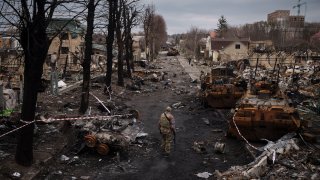
Spurred into action by reports of atrocities in Ukraine, NATO countries agreed Thursday to ramp up the supply of weapons to Kyiv, including hi-tech arms, amid concerns that Russia is about to launch a large offensive in Ukrarine's eastern Donbas region.
NATO, as an organization, refuses to send troops or weapons to Ukraine or impose a no-fly zone over it to keep the trans-Atlantic military group from being drawn into a wider war with nuclear-armed Russia. Individual NATO countries, however, have provided anti-aircraft and anti-tank weapons to Ukraine, as well as equipment and medical supplies.
“There was a clear message from the meeting today that allies should do more, and are ready to do more, to provide more equipment, and they realize and recognize the urgency,” NATO Secretary-General Jens Stoltenberg said after chairing a meeting of allied foreign ministers in Brussels.
Stoltenberg declined to say which countries were stepping up supplies or what kinds of equipment they might send, but he said: “Rest assured, allies are providing a wide range of different weapons systems, both Soviet-era systems but also modern equipment.”
U.S. Secretary of State Antony Blinken said the “sickening images and accounts coming out of Bucha and other parts of Ukraine” have strengthened the West’s resolve to punish Russia and step up support for Ukraine.
Blinken said the United States is “looking across the board right now not only at what we provided, and what we continue to provide, but whether there are additional systems that could make a difference.”
One of the drawbacks of sending modern arms is that Ukrainian troops would have to learn how to to use them, but some NATO nations raised the possibility of providing training outside of the war-ravaged country.
U.S. & World
Britain was also outspoken about its intentions.
“We’ve agreed to step up support for Ukraine and we’ve also recognized that the conflict has entered a new and different phase with a more concentrated Russian offensive,” British Foreign Secretary Liz Truss said.
“There was support for countries to supply new and heavier equipment to Ukraine so that they can respond to these new threats from Russia. We’ve agreed to help Ukrainian forces move from their Soviet-era equipment to NATO-standard equipment on a bilateral basis,” Truss said.
After talks with his NATO counterparts, Ukrainian Foreign Minister Dmytro Kuleba said he was cautiously optimistic that some countries would boost weapons supplies to his nation. But he warned that those arms must get to Ukraine quickly, with Russia set to attack more widely in the east.
“Either you help us now — and I’m speaking about days, not weeks — or your help will come too late,” Kuleba said his message was to NATO countries. Asked what more his country was seeking, Kuleba listed planes, land-based missiles, armored vehicles and air defense systems.
He also criticized some Western countries for failing to impose sanctions quickly enough, or of acting too late, highlighting his point with the reports of war crimes in the northern town of Bucha.
“How many Buchas have to take place for you to impose sanctions? How many children, women, men, have to die,” Kuleba said, “for you to understand that you cannot allow sanctions fatigue, as we cannot allow fighting fatigue?”
Some NATO countries sending weapons have been making a distinction about what kind of support they can provide, saying Ukraine should only receive arms for defensive purposes and not offensive weapons like war planes or tanks.
But Stoltenberg rejected the rhetorical arguments. “Ukraine is fighting a defensive war, so this distinction between offensive and defensive weapons doesn’t actually have any real meaning,” he said.
Stoltenberg said he has “urged allies to provide further support of many different types of systems, both light weapons but also heavier weapons.”
Despite the allegations of Russian war crimes and warnings that more atrocities might emerge, it appears unlikely, at least for now, that the world’s biggest security alliance will agree as an organization to arm Ukraine and help end Europe’s biggest land war since World War II.
___
Follow the AP’s coverage of the war at https://apnews.com/hub/russia-ukraine



